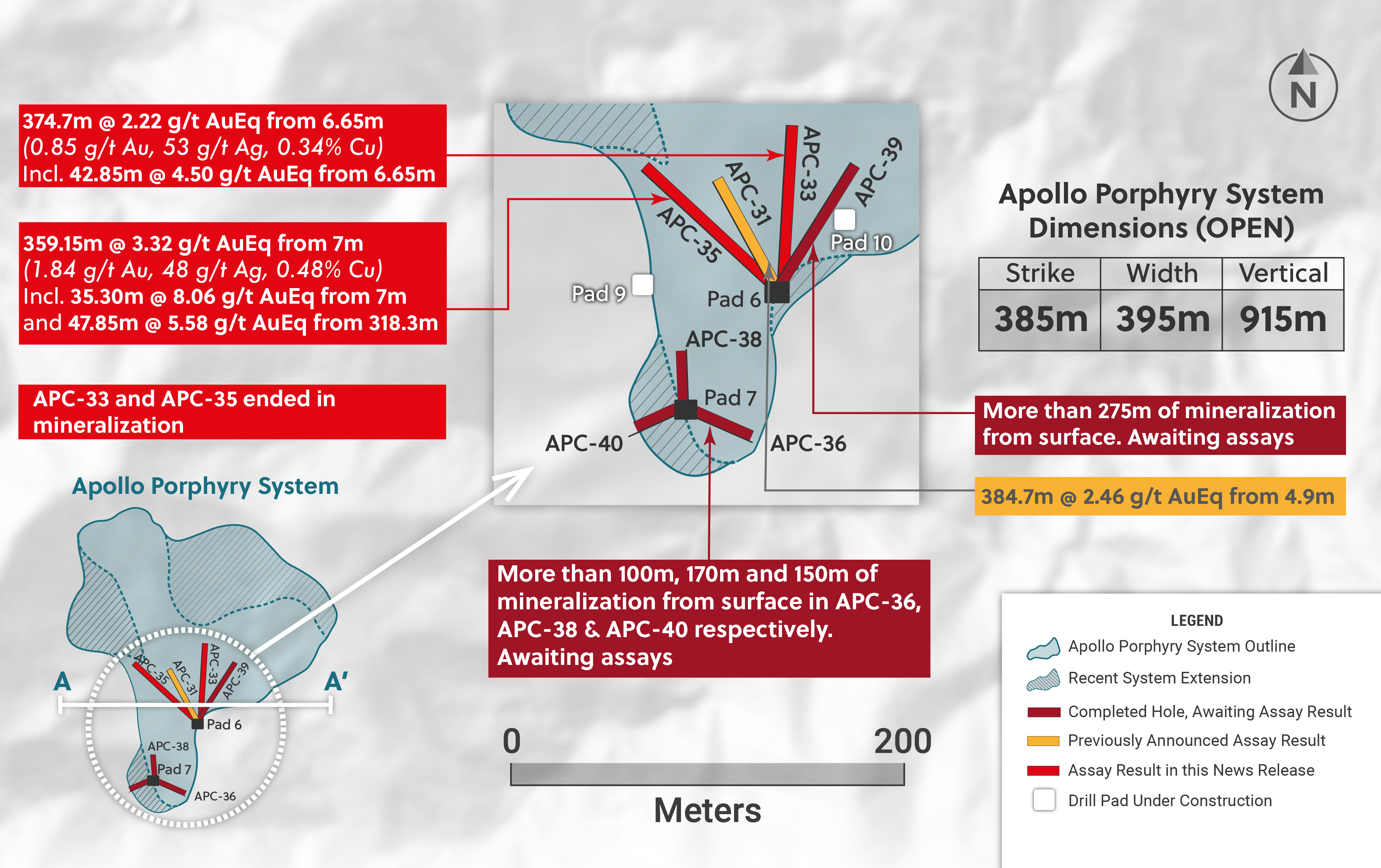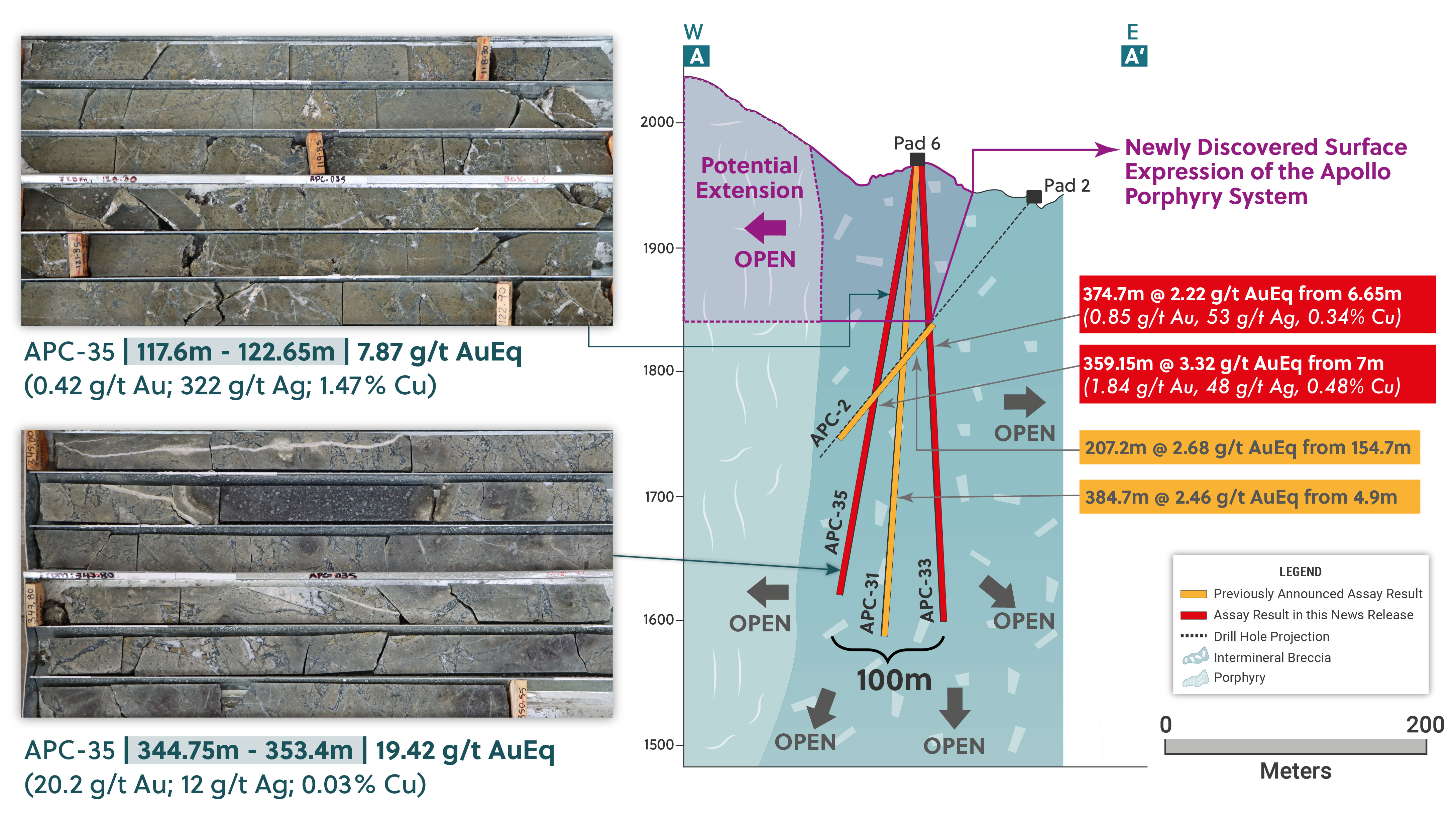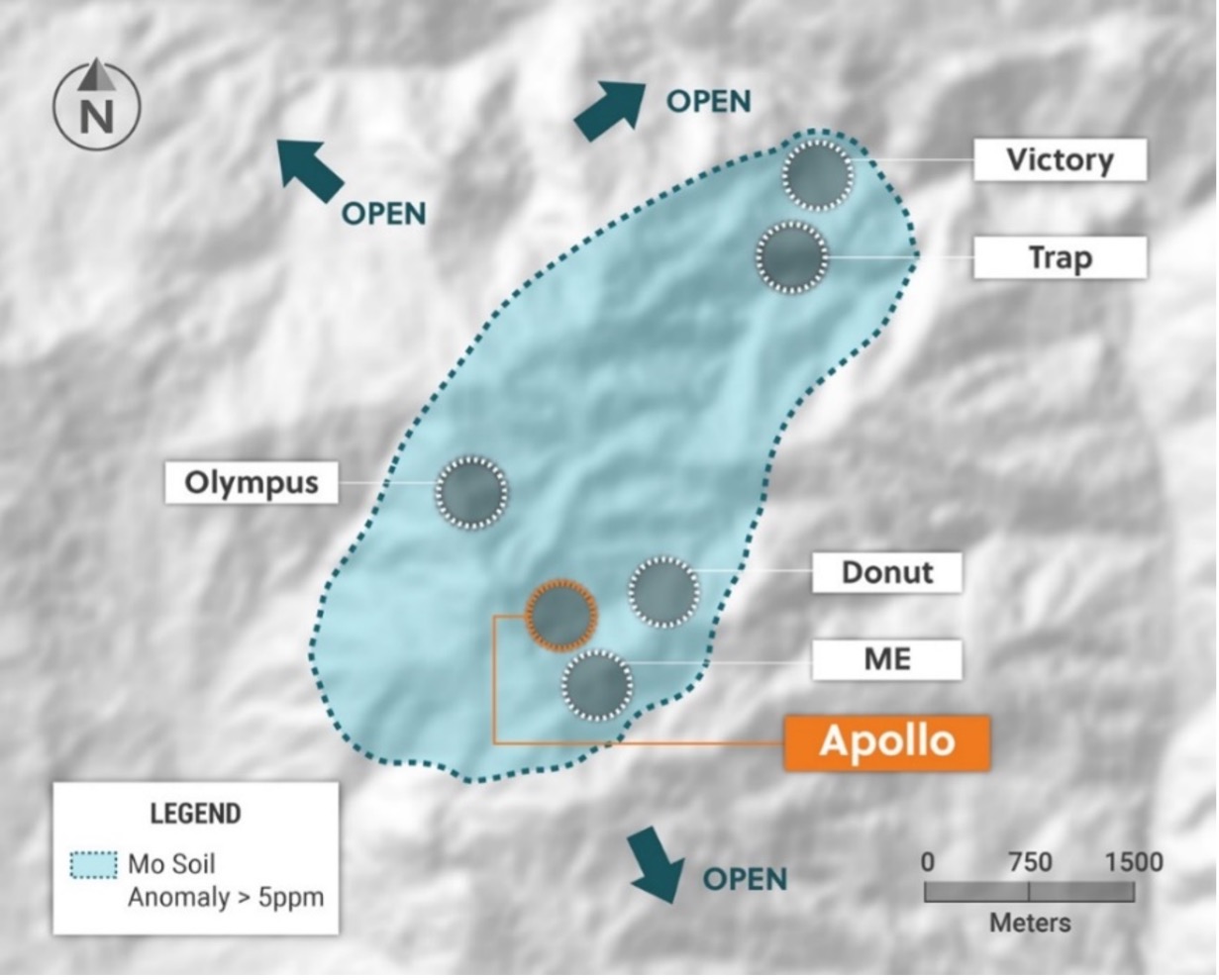- Assay results for two holes APC-33 and APC-35, intended to test the mineralized outcrop of the Apollo porphyry system, intersected significant continuous high-grade copper-silver-gold mineralization from surface as follows:
- 359.15 metres @ 3.32 g/t gold equivalent (consisting of 1.84 g/t gold, 48 g/t silver and 0.48% copper) in drill hole APC-35 including:
- 35.30 metres @ 8.06 g/t gold equivalent from surface in oxides, and
- 47.85 metres @ 5.58 g/t gold equivalent from 318.30 metres to the end of the hole.
- 374.70 metres @ 2.22 g/t gold equivalent (consisting of 0.85 g/t gold, 53 g/t silver and 0.34% copper) in drill hole APC-33 including:
- 42.85 metres @ 4.50 g/t gold equivalent from surface in oxides.
- The intersection in drill hole APC-35 is the highest grade (grams X metres) hole drilled to date at the Apollo porphyry system.
- Both holes terminated while still in strong mineralization at over 350 metres vertical depth. Deeper drilling is planned as part of the 2023 Phase II program.
- Significant and continuous copper mineralization was intersected in both drill holes beginning directly below the oxide zone of mineralization and continuing to the end of the holes.
- Four additional drill holes have been completed from drill Pads 6 and 7 with all four holes appearing to have intersected continuous mineralization from bedrock to downhole lengths of up to 275 metres. Assay results are pending.
- Outcrop mapping and sampling in the south and central portions of the Apollo porphyry system has outlined a 130 metres X 130 metres area of known surface mineralization which is open in all directions. Two new pads (9 and 10) are under construction and once operational will provide more drilling options to test this expanding area of surface and shallow mineralization.
Ari Sussman, Executive Chairman commented: “The Apollo deposit continues to demonstrate that it is in a rare class of discoveries combining both high-grades of copper, silver and gold hosted within a bulk tonnage porphyry system. Surprises through drilling continue to be positive with APC-35 being the highest grade intercept at the project to date. Importantly, the hole began and ended in two separate high-grade subzones of mineralization. Once the shallow portion of the drill program is completed in the coming weeks, we will immediately begin drilling significantly longer holes to test the full potential of the system from surface to depth. Assay turnaround continues to be quick and more results are expected in the near term.”
Toronto, Ontario, March 15, 2023 - Collective Mining Ltd. (TSXV: CNL, OTCQX: CNLMF) (“Collective” or the “Company”) is pleased to announce assay results from an additional two drill holes completed from Pad 6 as part of the Phase II program at the Guayabales project located in Caldas, Colombia. The aim of the Phase II program is to test and define through drilling the shallow portion of the Apollo porphyry system as well as continue expanding the system through step-out drilling. The Apollo porphyry deposit is a high-grade, bulk tonnage copper-silver-gold system, which owes its excellent metal endowment to an older copper-silver and gold porphyry system being overprinted by younger precious metal rich, carbonate base metal vein systems (low and intermediate sulphidation porphyry veins) within a magmatic, hydrothermal intermineral breccia body currently measuring 395 metres x 385 metres x 915 metres and open for expansion.
To watch a short video of David Reading, Special Advisor to Collective Mining, speak about the assay results announced today, please click here.
Details (See Table 1 and Figures 1-3)
The Phase II drilling program of 2023 is advancing on schedule with seven holes completed and a further three in progress. The aim of this program is to define the high-grade mineralization and dimensions of the Apollo porphyry system near surface while continuing to expand the size of the system through step-out drilling. To date, a total of 34 drill holes (approximately 16,000 metres) have been completed and assayed at the Apollo target with the majority of the holes testing the Apollo porphyry system.
Assay results for the first drill hole (APC-31) from the 2023 Phase II program was announced on February 23, 2023 and intersected 384.7 Metres at 2.46 g/t Gold Equivalent from surface which included high-grade oxide mineralization of 42.35 metres averaging 5.08 g/t gold equivalent.
A further two holes, APC-33 and APC-35 have now been completed from Pad 6 with assay results and geological observations summarized below.
APC-35 was drilled steeply to the northwest from Pad 6 to a maximum depth of 366.15 metres (350 metres vertical). The hole was designed to test the potential for shallow, high-grade mineralization located 50 metres west of APC-31. The hole intersected continuous mineralization from surface down to its final depth where it was terminated while still in strong mineralization (final 3.45m averaging 1.11 g/t gold equivalent). APC-35 is the highest-grade mineralization (grams X metres) reported from drilling to date as follows:
- 359.15 metres @ 3.32 g/t gold equivalent (consisting of 1.84 g/t gold, 48 g/t silver and 0.48% copper) including:
- 35.30 metres @ 8.06 g/t gold equivalent from surface (in oxides), and
- 47.85 metres @ 5.58 g/t gold equivalent from 318.30 metres.
The mineralized interval starts directly below overburden at 7 metres and into saprolite and oxide material until 42.30 metres before transitioning into fresh mineralized angular breccia rock consisting of chalcopyrite (0.2% to 1.5%), pyrite (1% to 2%) and some pyrrhotite (~1%). The mineralization is overprinted by carbonate-base metal veins containing sphalerite and galena and high grades of gold particularly from 318.30 metres downhole. Gold grades are significantly higher in the oxidized portion of the intercept while copper and silver grades are consistently high throughout the whole intercept below the oxidized zone.
APC-33 was drilled steeply to the north from Pad 6 to a maximum depth of 381.35 metres (360 metres vertical). The hole was also designed to test the potential for shallow, high grade mineralization located 50 metres east of APC-31. The hole intersected continuous mineralization from surface down to its final depth where it was terminated while still in strong mineralization (last 4.44 metres grade 1.7 g/t gold equivalent) and averaged:
- 374.70 metres @ 2.22 g/t gold equivalent (consisting of 0.85 g/t gold, 53 g/t silver and 0.34% copper) including:
- 42.85 metres @ 4.50 g/t gold equivalent from surface (in oxides).
The mineralized interval starts directly below overburden at 6.65 metres and into saprolite and oxide material until 49.50 metres before transitioning into fresh mineralized angular breccia rock consisting of chalcopyrite (0.2% to 1.2%), pyrite (1% to 2.5%) and some pyrrhotite (~1%). The sulphides fill the breccia matrix and are surrounded by clasts of quartz diorite and diorite. The mineralization is overprinted by carbonate-base metal veins containing sphalerite and galena. Gold grades are significantly higher in the oxidized portion of the intercept where copper grades are depleted.
Outcrop mapping and sampling in the south and central portions of the system has outlined a 130 metre-by-130 metre area of known surface mineralization, which is open in all directions. Pads 6 and 7 have been designed with the objective of understanding the styles and tenor of the shallow, high-grade mineralization from surface down to depths of up to 400 metres. Visual observations from another four completed holes indicate continuous intercepts from surface over core lengths ranging from more than 100 metres to more than 275 metres. The Company presently has three diamond drill rigs operating at the Apollo project and additional assay results are expected in the near term.
Two new drill pads, numbered 9 and 10, are under construction to provide further drilling options to test and expand upon the area which the Apollo porphyry system outcrops at surface.
The Apollo target area, as defined to date by surface mapping, rock sampling and copper and molybdenum soil geochemistry, covers a 1,000 metres X 1,200 metres area, and represents a large and unusually high-grade Cu-Ag-Au porphyry system. Mineralization styles include early-stage porphyry veins, inter-mineral breccia mineralization and multiple zones of porphyry related late stage, sheeted, carbonate-base metal veins with high gold and silver grades. The Apollo target area is still expanding as the Company’s geologists find more outcrop areas with porphyry veining, breccia, and late stage, sheeted, carbonate base metal veins.
Table 1: Assays Results for APC-33 and APC-35
| HoleID |
From
(m) |
To
(m) |
Intercept
Interval (m) |
Au
(g/t) |
Ag
(g/t) |
Cu
% |
Mo
% |
AuEq
(g/t)* |
CuEq
(%)** |
| APC-33 |
6.65 |
381.35 |
374.70 |
0.85 |
53 |
0.34 |
0.002 |
2.22 |
1.21 |
| Inlc** |
6.65 |
49.50 |
42.85 |
3.87 |
40 |
0.12 |
0.001 |
4.50 |
|
| APC-35 |
7.00 |
366.15 |
359.15 |
1.84 |
48 |
0.48 |
0.002 |
3.32 |
1.82 |
| Incl** |
7.00 |
42.30 |
35.30 |
7.96 |
22 |
0.09 |
0.001 |
8.06 |
|
| |
318.30 |
366.15 |
47.85 |
5.47 |
19 |
0.05 |
0.002 |
5.58 |
|
*AuEq (g/t) is calculated as follows: (Au (g/t) x 0.95) + (Ag g/t x 0.016 x 0.95) + (Cu (%) x 1.83 x 0.95)+ (Mo (%)*9.14 x 0.95) and CuEq (%) i: (Cu (%) x 0.95) + (Au (g/t) x 0.51 x 0.95) + (Ag (g/t) x 0.01 x 0.95)+ (Mo(%)x 3.75 x 0.95) CuEq (%) is calculated as follows: (Cu (%) x 0.95) + (Au (g/t) x 0.51 x 0.95) + (Ag (g/t) x 0.01 x 0.95)+ (Mo(%)x 5.0 x 0.95). utilizing metal prices of Cu – US$4.00/lb, Ag – $24/oz Mo US$20.00/lb and Au – US$1,500/oz and recovery rates of 95% for Au, Ag, Mo and Cu. Recovery rate assumptions are speculative as no metallurgical work has been completed to date
** A 0.2 g/t AuEq cut-off grade was employed with no more than 15% internal dilution. True widths are unknown, and grades are uncut
Oxidation zone**
Figure 1: Plan View of the Apollo Porphyry System Highlighting Drill Holes APC-33 & APC-35

Figure 2: Core Photo Highlights and Cross Section for Drill Holes APC-33 and APC-35

Figure 3: Plan View of the Guayabales Project Highlighting the Apollo Target Area

About Collective Mining Ltd.
To see our latest corporate presentation and related information, please visit www.collectivemining.com
Founded by the team that developed and sold Continental Gold Inc. to Zijin Mining for approximately $2 billion in enterprise value, Collective Mining is a copper, silver and gold exploration company with projects in Caldas, Colombia. The Company has options to acquire 100% interests in two projects located directly within an established mining camp with ten fully permitted and operating mines.
The Company’s flagship project, Guayabales, is anchored by the Apollo target, which hosts the large-scale, bulk-tonnage and high-grade copper-silver-gold Apollo porphyry system. The Company’s near-term objective is to drill the shallow portion of the porphyry system while continuing to expansion the overall dimensions of the system, which remains open in all directions.
Management, insiders and close family and friends own nearly 52% of the outstanding shares of the Company and as a result, are fully aligned with shareholders. The Company is listed on the TSXV under the trading symbol "CNL" and on the OTCQX under the trading symbol “CNLMF”.
Qualified Person (QP) and NI43-101 Disclosure
David J Reading is the designated Qualified Person for this news release within the meaning of National Instrument 43-101 (“NI 43-101”) and has reviewed and verified that the technical information contained herein is accurate and approves of the written disclosure of same. Mr. Reading has an MSc in Economic Geology and is a Fellow of the Institute of Materials, Minerals and Mining and of the Society of Economic Geology (SEG).
Technical Information
Rock and core samples have been prepared and analyzed at SGS laboratory facilities in Medellin, Colombia and Lima, Peru. Blanks, duplicates, and certified reference standards are inserted into the sample stream to monitor laboratory performance. Crush rejects and pulps are kept and stored in a secured storage facility for future assay verification. No capping has been applied to sample composites. The Company utilizes a rigorous, industry-standard QA/QC program.
Information Contact:
Follow Executive Chairman Ari Sussman (@Ariski) and Collective Mining (@CollectiveMini1) on Twitter
Investors and Media
Paul Begin, Chief Financial Officer
[email protected]
+1 (416) 451-2727
FORWARD-LOOKING STATEMENTS
This news release contains certain forward-looking statements, including, but not limited to, statements about the drill programs, including timing of results, and Collective’s future and intentions. Wherever possible, words such as “may”, “will”, “should”, “could”, “expect”, “plan”, “intend”, “anticipate”, “believe”, “estimate”, “predict” or “potential” or the negative or other variations of these words, or similar words or phrases, have been used to identify these forward-looking statements. These statements reflect management’s current beliefs and are based on information currently available to management as at the date hereof.
Forward-looking statements involve significant risk, uncertainties, and assumptions. Many factors could cause actual results, performance, or achievements to differ materially from the results discussed or implied in the forward-looking statements. These factors should be considered carefully, and readers should not place undue reliance on the forward-looking statements. Although the forward-looking statements contained in this news release are based upon what management believes to be reasonable assumptions, Collective cannot assure readers that actual results will be consistent with these forward-looking statements. These forward-looking statements are made as of the date of this news release, and Collective assumes no obligation to update or revise them to reflect new events or circumstances, except as required by law.
Neither the TSXV nor its Regulation Services Provider (as that term is defined in the policies of the TSXV) accepts responsibility for the adequacy or accuracy of this news release.


